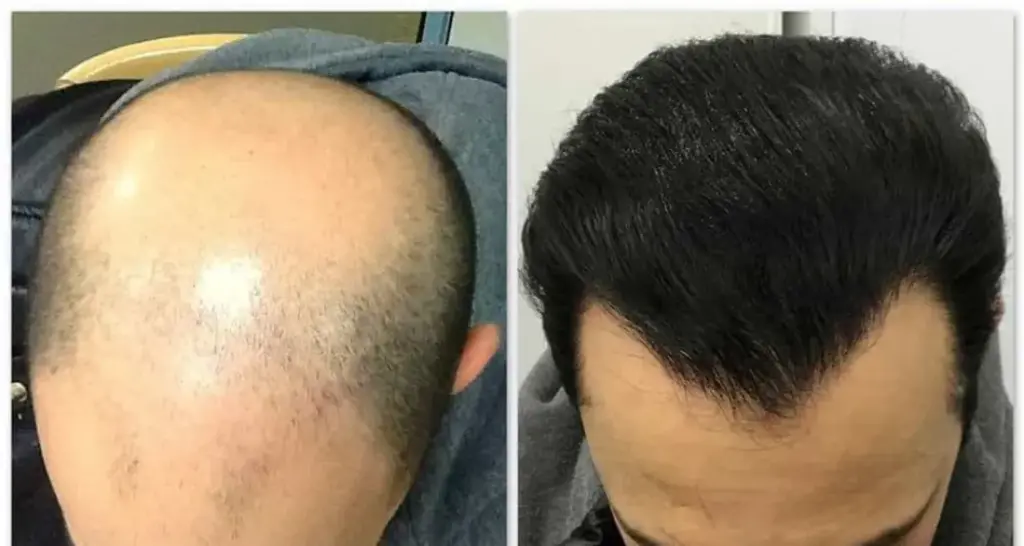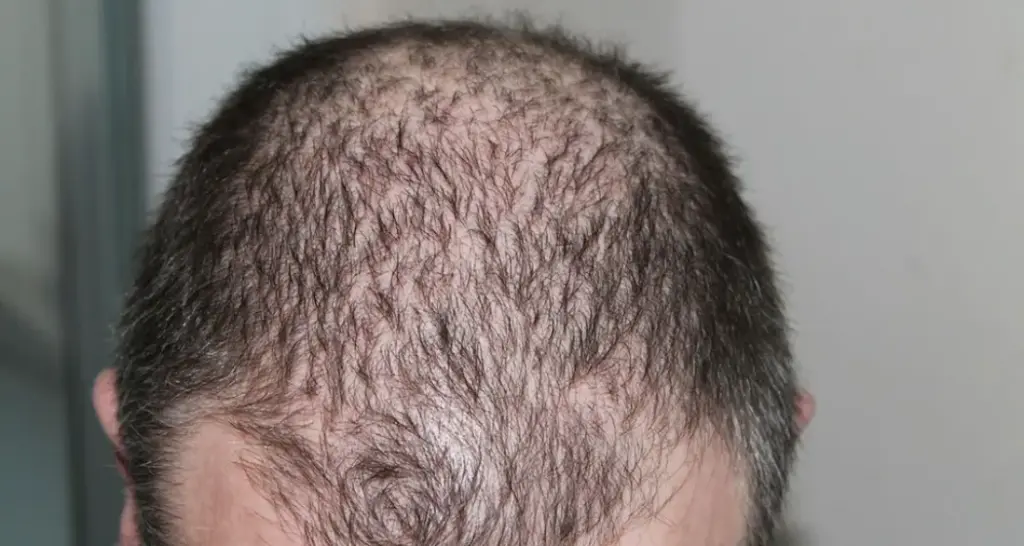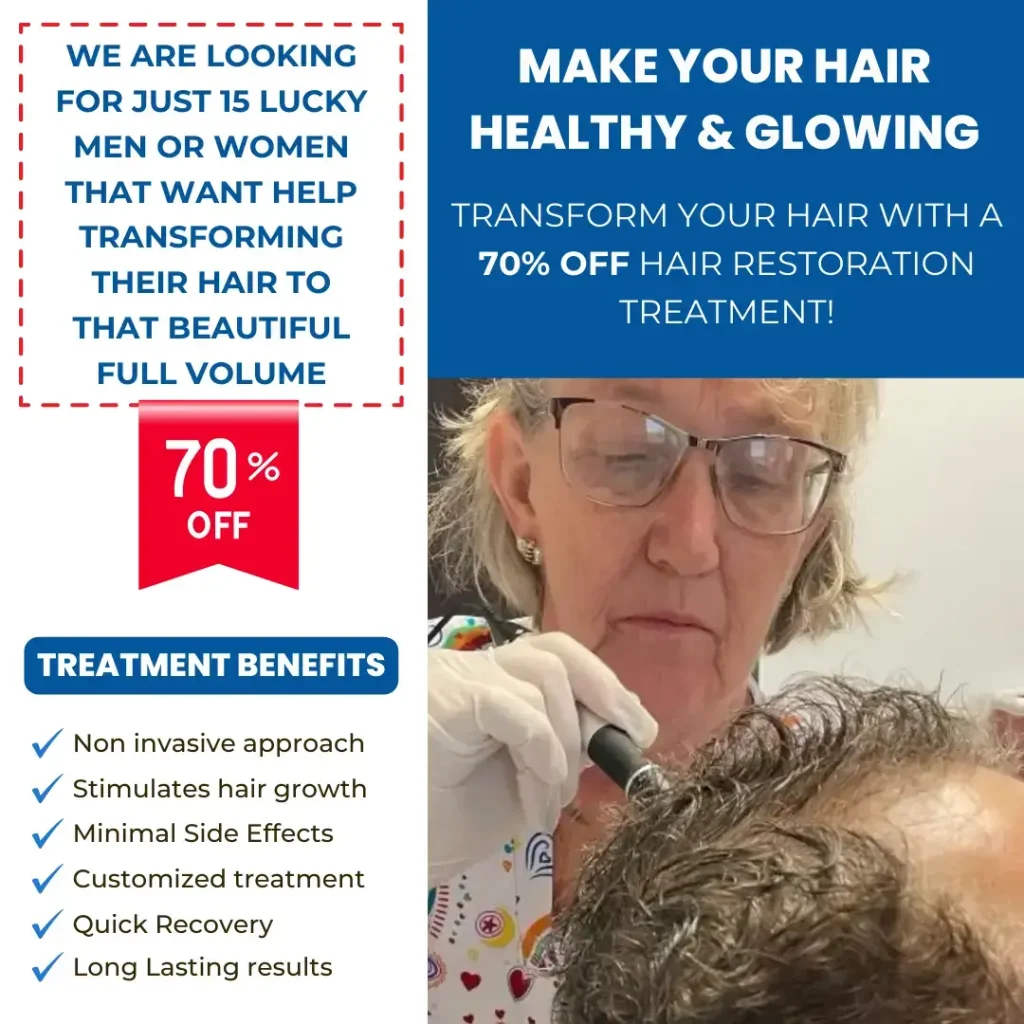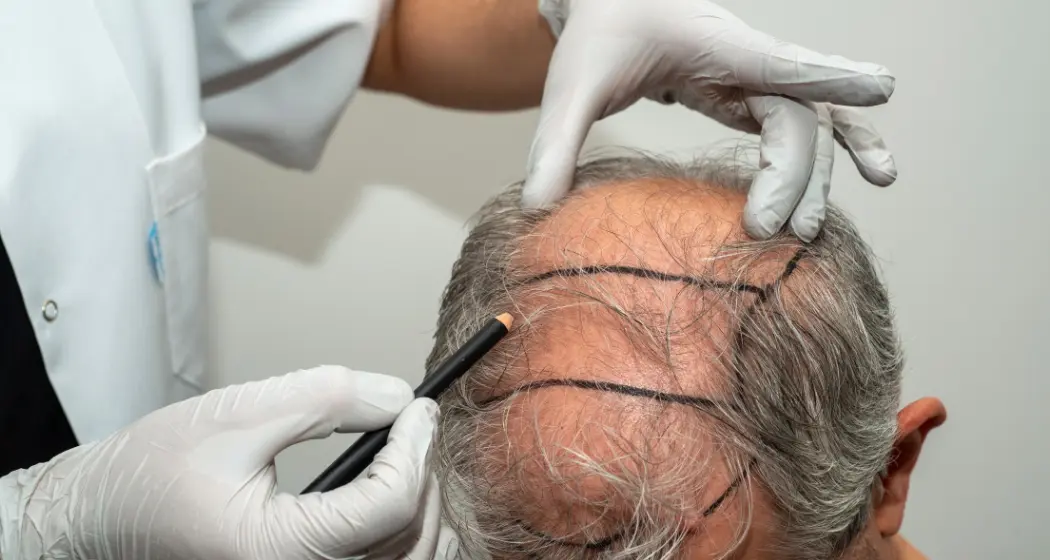Table of Contents
ToggleKey Takeaways
- Hair restoration options vary from non-surgical methods like laser treatments to surgical procedures such as hair transplants, each with its own strengths and suitability.
- Understanding the underlying causes of hair loss, including genetics and lifestyle, is crucial in selecting the most effective treatment approach.
- A hair transplant is a detailed procedure that requires choosing the right clinic and specialist, understanding what to expect, and following post-procedure care for optimal results.
- Consider laser hair restoration as a non-invasive alternative, weighing its benefits and limitations carefully before making a decision.
- Personalized treatment plans are key, and professional consultation is vital to tailor the solution to your specific hair loss condition, goals, and expectations.
Understanding Hair Loss and Restoration Options
Understanding the severity and type of hair loss you are experiencing is vital for choosing the most suitable treatment path. Early detection and accurate diagnosis are pivotal for effective intervention. Here are some signs to watch for:
- Receding Hairline: A hairline that appears higher than usual may indicate the onset of hair loss.
- Thinning Hair: Noticeable thinning when parting your hair could be a sign of progressive hair loss.
It’s important to understand that hair loss is a complex issue influenced by various of factors. A professional assessment by a hair loss expert is invaluable, as they can consider your medical history, lifestyle, and genetic factors to recommend the most appropriate treatment options. Experts are also abreast of the latest advancements, potentially offering access to new and effective treatments.
The Pull Test, as mentioned by the Mayo Clinic, is a simple diagnostic procedure where a doctor gently pulling several dozen hairs to see how many come out, helping to determine the stage of the shedding process.
Comparing Hair Restoration and Transplant Techniques
When considering hair recovery options, it’s crucial to grasp that hair restoration is not a one-size-fits-all solution. The effectiveness of hair restoration techniques can vary greatly depending on individual factors and the chosen technique to be used.
Hair restoration encompasses a range of techniques, each with its own set of advantages and considerations. It’s important to compare these methods to determine which one aligns best with your unique hair loss situation and recovery goals.
Here’s a brief comparison of two popular hair transplant techniques:
- Follicular Unit Transplantation (FUT): Involves removing a strip of scalp with hair and then transplanting individual hair follicles to the affected area. It’s often preferred for covering larger areas of hair loss.
- Follicular Unit Extraction (FUE): This technique involves directly individual hair follicles from the scalp, followed by transplantation. It’s known for leaving less noticeable scarring and is great for patients who prefer shorter hairstyles.
Choosing the right technique involves assessing your hair loss type, the desired outcome, and personal preferences. It’s also essential to consider the qualifications and experience of the surgeon, as these can significantly impact the success of the procedure.
The Role of Genetics and Lifestyle in Hair Loss
Understanding the complex relationship between genetics and lifestyle is crucial when addressing hair loss. Genetics often play a significant role in conditions like Male and Female Pattern Hair Loss, which are common hereditary causes. These androgen-related forms of alopecia are leading reasons for seeking hair loss treatment.

Hair loss is complicated issue with many reasons contributing factors, and a personalized approach is essential for effective treatment.
While genetics set the stage for hair loss, lifestyle factors like diet, stress, and hormonal imbalances also contribute significantly. It’s important to assess all potential causes to develop a comprehensive treatment plan. Consulting with a hair loss expert can provide personalized guidance, considering your medical history, lifestyle, and genetic predisposition.
- Primary Cause of Hair Loss: Hereditary (80% of cases)
- Individual Variation: Onset age and progression rate differ
- Common Type: Androgenic alopecia
- Treatment Challenge: Genetic root cause cannot be altered
The Hair Transplant Process Explained
Embarking on a hair transplant journey begins with a thorough initial consultation, where your hair loss pattern is evaluated and treatment plans are discussed. This step is vital for setting realistic expectations and preparing for the procedure.
What to Expect During a Hair Transplant
On the day of the surgery, you will receive local anesthesia in both the donor and recipient areas to ensure comfort. The length of the procedure depends on the chosen technique.
- FUT (Follicular Unit Transplantation): Typically takes 4 to 8 hours.
- FUE (Follicular Unit Extraction): May take a similar amount of time, with some variations depending on individual cases.
During the surgery, you can relax by listening to music or watching television. The environment is designed to be as comfortable as possible to ease any anxiety.
Post-procedure care is an integral part of the hair transplant process. It involves following specific guidelines to ensure proper healing and optimal results. Your specialist will offer comprehensive guidance on scalp care and discomfort management throughout the recovery process.
Choosing the Right Clinic and Specialist
Selecting the ideal hair transplant clinic is a critical step in your hair recovery journey. The competence and expertise of the surgeon, along with the clinic’s technology and patient care methodology, are pivotal factors that influence the success of the procedure. For an informed decision, follow these steps:
- Research and Reviews: Start by researching clinics that specialize in hair transplants. Read reviews and feedback from past patients to assess the clinic’s reputation.
- Consultations: Schedule consultations with potential surgeons to discuss their experience, view before-and-after photos, and understand their approach to hair transplant procedures.
- Comfort and Trust: Ensure you feel comfortable with the surgeon and their team. Effective communication and trust are essential for achieving a positive outcome.
Making a well-informed choice is paramount, as it significantly impacts both the transplant results and your overall experience.
Remember, our medical consultants are available for a pre-consultation to address any inquiries, offer expert guidance, and assist you in making the optimal decision tailored to your specific needs.
Post-Procedure Care and Maintenance
After a hair transplant, the journey to full recovery and the unveiling of your new hairline begins. The first few days post-procedure are critical for ensuring a successful outcome. Patients are provided with detailed written post-operative guidelines to follow, which include taking prescribed painkillers, keeping the surgical area clean and properly bandaged, and understanding the healing timeframes and expectations.
Recovery from hair transplant surgery is not just about the immediate aftermath; it involves a series of follow-up appointments. These are essential for monitoring the healing process and the progression of hair growth. Typically, appointments are scheduled at two weeks, three months, six months, nine months, and the final one at 12 months post-surgery.
For optimal results and maintain the health of your transplanted hair, consider the following steps:
- Schedule Follow-Up Appointments: Regular check-ins with your specialist are vital to monitor progress and ensuring any needed adjustments.
- Implement Lifestyle Changes: Incorporate recommended lifestyle modifications, such as diet, stress management, and exercise, to support your hair health.
- Stay Informed and Patient: Hair growth is a gradual process. Educate yourself about what to expect and be patient as your hair recovers.
Laser Hair Restoration: A Non-Surgical Approach
Laser hair restoration stands out as a non-invasive alternative to traditional hair loss treatments. Utilizing low-level laser therapy (LLLT), this method stimulates hair follicles, promoting growth and a fuller appearance. The underlying mechanism, known as photobiomodulation, involves laser light to enhance cellular activity and hair regeneration.
How Laser Hair Restoration Works
Laser hair restoration targets the follicles directly, providing a focused and effective method to combat hair loss.
The advantages of laser hair restoration extend beyond its efficacy. It is also recognized for its safety, as there are no incisions involved, thus minimizing the risk of infection or complications. Additionally, the convenience factor is significant; sessions are quick and do not demand the daily commitment required by some topical or oral treatments.
Benefits and Limitations of Laser Treatments
Laser hair restoration is a modern approach that offers a non-invasive solution with minimal downtime, making it an attractive option for many. It is particularly beneficial for those seeking a convenient treatment that can be performed at home. However, it’s important to recognize that laser treatments may not be suitable for severe cases of hair loss.
While laser therapy is effective and safe, the results require patience and consistency in treatment application.
- Lifestyle Compatibility: Laser treatments offer the convenience and privacy of home use, while traditional methods may require clinic visits or surgery.
- Budget Considerations: Laser devices typically involve a one-time purchase cost, in contrast to the recurring costs associated with traditional methods like surgery, follow-up appointments, and medications.
- Patience for Results: Expectations should be set for a gradual improvement, as laser hair restoration doesn’t provide immediate results.
It is evident that the choice between laser and traditional hair restoration methods should be informed by a thorough understanding of their respective benefits and limitations. This ensures that the selected treatment aligns with one’s personal hair restoration goals and circumstances.
What You Need to Know Before Choosing Laser Hair Restoration
Choosing the right hair loss treatment is a personal decision that should be based on accurate information and professional advice. Consultation with a specialist is crucial to understand if laser hair restoration is suitable for your specific type of hair loss.
Before making a decision, it’s important to compare laser hair restoration with traditional methods. Consider the following points:
- Efficacy: Studies indicate laser treatments can promote hair growth by targeting follicles directly.
- Safety: Assess the risks and side effects associated with laser treatments.
- Convenience: Determine if the treatment schedule can be accommodated within your daily routine.
- Cost: Evaluate the overall expense, including any maintenance treatments.
When selecting a laser, it’s important to consider factors such as fluence, spot size, cooling for pain reduction, and repetition rate.
Remember, the best choice varies from person to person. Weighing the innovative approach of laser hair restoration against traditional methods will help you choose the solution best meets your needs and expectations.
Another Hair Restoration Approach: Regenerative Medicine
Regenerative medicine offers a natural hair restoration technique with proven results to regrow hair without the need for drugs or invasive procedures. Moreover, Regenerative medicine therapies, including human cellular tissue amniotic allografts or platelet-rich plasma (PRP) injections have the potential to stimulate your hair follicles for hair regrowth. Regenerative therapies have proven effective for hair restoration, offering a natural, non-surgical option for both females and males seeking hair loss treatment.
Human cellular tissue, including Amniotic tissue allograft injections and Plasma injections, is rich in growth factors. possess therapeutic properties to stimulate natural hair regrowth. These products are also rich in cellular signaling makers that stimulate tissue regeneration in the areas being treated and support your body’s natural ability to heal.
Amniotic fluid is rich in beneficial cytokines, which are a type of cell signaling protein. It means that they are like foremen in construction, telling other cells where to go and what to do.
Amniotic fluid cytokines comprise various groups of proteins, including growth factor cytokines. These growth factors stimulate cellular activity and tissue growth, promoting various connective tissues and cell types similar to those found in the dermal and epidermal tissues of the scalp.
Let’s examine some of the growth factors responsible for success when using amniotic fluid for hair loss. These include Epidermal growth factors, Vascular growth factors, and plasma-derived growth factors.
Epidermal Growth Factor (EGF) is a key growth factor found in amniotic fluid and tissue products, responsible for cell growth and proliferation. It can essentially activate hair follicle cells, inducing them to enter a state of proliferation where they actively produce hair.
Vascular Endothelial Growth Factor is crucial for both the formation and regeneration of blood vessels.
It stimulates the regeneration of the scalp’s blood delivery system, a process known as angiogenesis and revascularization, which involves the formation of new blood vessels in dermal tissues.
Plasma-derived Growth Factor (PDGF) is another growth factor responsible for blood vessel formation, also known as angiogenesis, as mentioned earlier. Many more cytokines are present in amniotic fluid and tissue products, which contribute to the positive outcomes seen in amniotic fluid for hair loss treatments. The synergy of these cytokines culminates in a hair loss treatment unparalleled by any other.
Another advantage of utilizing amniotic fluid for hair loss treatments is its ready availability. It can be conveniently stored on-site, allowing for immediate treatment availability. While all types of regenerative treatments and therapies have their merits, in this instance, the simplicity, convenience, and ready availability of amniotic fluid for hair loss treatment appear to be the ideal option for promoting hair regrowth.
Plasma therapy stands as another excellent option for hair growth and restoration. Enriched with platelets and blood cell fragments, plasma is abundant in rejuvenating growth factors that hasten cellular growth and prompt cells to begin regrowing thicker, healthier strands of hair.
We can produce a highly concentrated solution by drawing a sample of your blood, separating the platelets, and concentrating them. Once injected into your scalp, the serum boosts hair growth. For further information on regenerative medicine therapies and treatments for hair restoration in the St. Petersburg area, contact Waters Edge Medical Clinic and Spa at 727-550-0855.
Making the Decision: Hair Restoration vs. Hair Transplant
When considering hair restoration or transplant, reflecting on your personal goals and expectations is crucial. Start by assessing the severity and type of your hair loss, as this will influence the most suitable treatment option. For instance, laser treatments may be more effective for mild to moderate hair loss.
Evaluating Your Hair Loss Goals and Expectations
Before diving into any treatment, think about what you hope to achieve. Are you looking to slow down hair loss simply, or are you aiming for a significant regrowth? Understanding your objectives will assist you in making the appropriate choices.

Monitoring your progress and being realistic about the outcomes is also important. Hair restoration can offer remarkable changes, but it’s not a one-size-fits-all solution. Regularly taking photos and noting improvements can help you and your specialist determine if your current treatment plan is effective or if it needs adjustment.
Cost Considerations and Long-Term Outcomes
Cost considerations play a pivotal role when weighing the options between hair restoration and hair transplant. A hair transplant is a much higher cost and a bigger investment choice. It is also a much more invasive and painful procedure. On the other hand, non-surgical treatments may appear less expensive upfront but can accumulate higher costs over time due to the need for ongoing treatments. However, they are more natural and less invasive. Regenerative medicine treatments are also cost effective due to the fact that they are regenerating hair follicles and cells.
The financial investment for hair restoration varies significantly and is influenced by several factors, including the extent of hair loss, the number of sessions needed, and the selected treatment method.
Here’s a quick comparison of potential costs:
- Hair Transplant: A one-time procedure with costs ranging from $5,800 to $16,800, depending on the scope and number of procedures needed.
- Laser Hair Restoration: Involves a one-time purchase of the device, with no additional costs for clinic visits or surgery.
- Traditional Methods: May include surgery costs, follow-up appointments, and medication expenses.
- Regenerative medicine: Can be one procedure or several procedures and the cost can range from $1,000 to $10,000 depending on the number of procedures and the products.
Considering the financial aspect, the longevity of results, and how the treatment aligns with your lifestyle. Hair transplants offer a permanent solution, while other methods may require continuous investment to maintain hair growth.
Personalized Treatment: Tailoring the Solution to Your Needs
When it comes to hair restoration, personalization is key. Every individual’s hair loss situation is unique, and so should be the approach to treatment. Tailored treatment plans are the foundation of effective hair recovery, taking into account your medical history, lifestyle, and specific hair loss pattern.
Experts in the field emphasize the importance of a customized strategy, one that combines modern technology with expert medical care. This ensures not only convenience and comfort but also continuous support and guidance on your journey to hair health.
The process of personalizing treatment extends beyond the initial consultation. It includes ongoing adjustments to the treatment plan based on your progress and response.
Here’s a brief overview of what a personalized treatment plan might include:
- Evaluation of medical history and hair loss pattern
- Customized treatment recommendations
- Personalized post-treatment care and support
- Continuous monitoring and adjustments as needed
Remember, what works for one individual may not work for another. It’s about finding the most effective path to your hair health that is both accessible and tailored to your needs.
Taking the Next Step in Your Hair Recovery Journey
Seeking professional advice through a consultation is a critical step in your hair recovery journey. Experts can offer personalized insights tailored to your medical history, lifestyle, and the specific pattern of your hair loss. This personalized approach guarantees that the treatment plan is optimized for your unique situation, enhancing the likelihood of successful hair restoration.
Consultation: The Importance of Professional Advice
When considering hair recovery options, a consultation is not just about gathering information; it’s about building a relationship with a specialist who understands your concerns and can lead you through the process with empathy and expertise.
Online consultations have revolutionized the accessibility of expert guidance, offering convenience and flexibility. Here’s what you can expect from a professional consultation:
- Evaluation of your hair loss condition
- Discussion of potential treatment options
- Development of a personalized treatment plan
- Answers to all your questions and concerns
Remember, the decision to pursue hair restoration or a hair transplant is significant, and professional advice is essential to ensure informed decision-making that aligns with your expectations and objectives.
Regaining Confidence: The Psychological Impact of Hair Recovery
The psychological impact of hair loss is significant, often leading to diminished self-esteem and confidence. Restoring your hair can lead to a profound positive change in how you perceive yourself and interact with others. The transformation extends beyond the physical appearance; it’s about reclaiming a part of your identity.
Hair recovery is not just a journey back to a fuller head of hair, but a step towards regaining the confidence that may have been lost along the way. It’s about feeling comfortable in your own skin and presenting yourself to the world with renewed self-assurance.
The benefits of hair recovery are not solely aesthetic. They translate into various aspects of life, including:
- Personal: Enhanced self-image and comfort in social situations.
- Professional: Increased confidence can lead to better first impressions and interactions.
- Emotional: A sense of control over one’s appearance, contributing to overall well-being.
Planning for the Future: Longevity of Hair Recovery Results
When considering hair recovery treatments, it’s essential to think about the long-term outcomes. Hair transplants are often touted as a permanent solution, with the transplanted hair follicles continuing to grow seamlessly alongside the rest of your natural hair. However, the full story involves understanding the nuances of genetics and aftercare that can affect the longevity of the results.
The procedure involves the transplantation of your own hair, ensuring that the transplanted hair matches the rest of your hair in terms of color, texture, and growth pattern.
While hair transplants may offer long-lasting results, it’s important to note that no treatment can change your genetic predisposition for hair loss. To maintain the best possible outcome, a combination of lifestyle adjustments and follow-up treatments may be necessary. Although this process is still considered newer technology, the results have been impressive when considering regenerative medicine for hair restoration. Showing changes and growth of your own hair follicles. This process takes longer, due to having to regenerate tissue and hair follicles, but the outcomes can be extremely beneficial. However, it is also essential to consider strategies for continued support. Here are some strategies to consider:
- Following a healthy diet and exercise regimen
- Avoiding harsh chemicals and heat styling tools
- Scheduling periodic check-ups with your hair specialist
Conclusion
In the journey to restore your hair, the choice between hair restoration and hair transplant is a deeply personal one that hinges on your unique circumstances and preferences. Whether you prioritize the treatment’s effectiveness, safety, convenience, or cost, it’s crucial to make an informed decision based on professional advice and thorough research. Hair transplants provide a lasting and authentic solution, often preferred for more severe cases of hair loss, while hair restoration techniques like laser therapy and regenerative medicine can be suitable for moderate to milder conditions.
Ultimately, the best choice is the one that aligns with your hair loss severity, lifestyle, and the outcomes you hope to achieve. Remember, regaining your hair can significantly boost your confidence and quality of life, so take the time to choose the right path.
Frequently Asked Questions

How do I assess the severity and type of my hair loss?
Assessing the severity and type of hair loss involves examining the pattern and extent of hair thinning or balding. A dermatologist or hair specialist can assess the cause and suggest appropriate treatment options.
What are the main differences between hair restoration and hair transplant techniques?
Hair restoration generally refers to non-surgical methods such as medications, laser treatments as well as regenerative treatments that aim to promote regeneration, hair growth, hair thickening or reduce hair loss. A hair transplant involves surgically relocating hair follicles from one part of the scalp to another.
What role does genetics play in the onset of hair loss?
Genetics significantly influences hair loss, especially in male and female pattern baldness. Genetic predisposition determines the sensitivity of hair follicles to hormonal changes that can lead to hair thinning.
What is the typical experience during a hair transplant procedure?
In a hair transplant procedure, follicles are typically harvested from a donor area and meticulously implanted into balding or thinning regions. Local anesthesia is commonly administered, and the duration can vary, contingent upon the scale of the transplant.
What are the limitations and benefits of laser hair restoration treatments?
Laser hair restoration treatments can stimulate hair growth and improve hair density without surgery. However, they may be less effective for advanced hair loss and require ongoing treatment to maintain results.
What are the benefits and limitations of regenerative medicine for hair restoration treatments?
Regenerative medicine is considered a new technology for hair restoration. This procedure helps regenerate damaged tissue and increase angiogenesis, allowing for increased viability and cell formation. Patients will experience thicker and fuller hair. This procedure takes time and is not instant since it causes new cell growth and regeneration.
How do I choose the right clinic and specialist for a hair transplant?
Choosing the right clinic involves researching the specialists’ qualifications and experience, reading patient reviews, considering the technology and methods used, and having a thorough consultation to discuss your expectations and concerns. If you are looking for alternative solutions for hair loss and are looking towards regenerative medicine, Waters Edge Medical Clinic and Spa has the solution. We are offering a free consultation at 727-550-0855.


